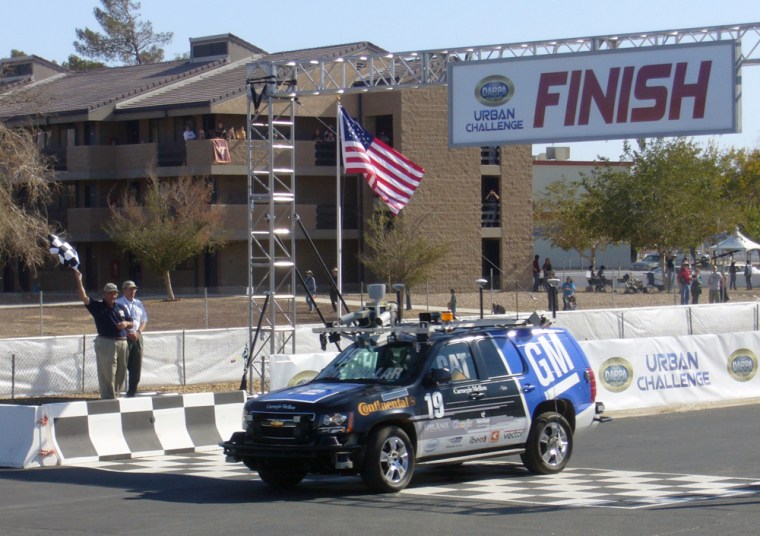The Tartan Racing Team, based at Carnegie Mellon University, walked away with a $2 million prize on Sunday for coming in first in this year's Pentagon-sponsored robot race, held at a former Air Force base.
The team's robotic vehicle, "Boss," turned in the top performance as it navigated itself through the 60-mile (100-kilometer) Urban Challenge course at the former George Air Force Base in Victorville this weekend.
The Pentagon's Defense Advanced Research Projects Agency took over the deserted base for the past week to offer an obstacle course tailor-made for city traffic. Boss, a modified Chevy Tahoe, competed along with 10 other robo-vehicles in Saturday's finals. The cars had to merge into moving traffic, navigate traffic circles, avoid obstacles and negotiate traffic jams without human intervention.
"This is really a fantastic accomplishment," Tony Tether, director of DARPA, said at Sunday's awards ceremony. "I watched these things driving, and I forgot after a while that there was nobody in there."
The winner was judged based on safety points as well as speed. Stanford Racing's "Junior," a Volkswagen Passat station wagon that was robotized by a Stanford University team, won the $1 million second-place prize. Victor Tango's "Odin," a Ford Escape SUV that was modified by a team from Virginia Tech and Torc Technologies, received $500,000 for finishing third.
Saturday's finals attracted hundreds of spectators, including 10-year-old Vernon Bussler, who compared the results to a robot arm and scorpion he had made out of Lego play bricks. "It's just different from the Lego — just way more things on it," he said.
Encouraging future scientists is part of the goal of the robot car race, the latest U.S. Defense Department challenge to universities, companies and inventors who last turned out in 2005 to send self-controlled vehicles more than 100 miles (160 kilometers) through the desert between Los Angeles and Las Vegas.
The cars run completely by computer, without human intervention, using sensors to plot and pick their way. DARPA sees the competition as a way to help fulfill a congressional mandate calling for a third of the military's ground combat vehicles to go driverless by the year 2015.
Negotiating traffic jams
Saturday's race was by no means a demolition derby: The cars were programmed to drive conservatively, and a mobile team of about 50 humans monitored the competition, ready to flip a remote-controlled off switch at the slightest hint of robot road rage.
Over and over, cars equipped a warning horn and roof-rack of space-age gear came to a perfect halt at the stop sign of a deserted intersection, then pulled through smoothly. The most spectacular error was a minor fender bender that did not stop or significantly damage either vehicle.
The winning car blended defensive driving with an extra drive to get ahead of the pack. "Boss is kind of like a soccer mom with some place to be — aggressive but safe," Tartan Racing team member Bryan Salesky explained.
Five finalists bogged down early. One car ended up in a driveway, its sensors continuing to swivel. A 24,500-pound (11-metric-ton) self-controlled green truck called the TerraMax halted inches away from mowing down a column. In qualifying events, robot cars simply stopped, lost in thought, climbed over curbs and sideswiped parked vehicles in this windy desert facility 80 miles (128 kilometers) northwest of Los Angeles.
"It's getting a little monotonous to see everybody do so well," joked Gerry Mayer, director of Lockheed Martin's Artificial Intelligence Laboratories, which worked with the University of Pennsylvania and Lehigh.
Remembrances of robots past
The results were a lot better than those of the first Grand Challenge by the U.S. Defense Advanced Research Projects Agency, the Defense Department's research arm. Not one robo-car finished that 2004 cross-desert race.
Chris Yakes, Oshkosh Truck Corp's advanced products director, described how a computer memory error ended the first trial for his truck. "The last thing it saw was a bush in front of it," he sighed.
An Oshkosh truck finished the 2005 desert race with flying colors, although its Urban Challenge entry, the TerraMax, did not finish. "Other than having a kid or getting married, I don't know if there's anything more exciting than seeing your robot coming over the horizon and bounding past the finish line at 45 miles per hour," Yakes said, remembering the 2005 race.
Oshkosh trucks supply U.S. troops in Iraq and elsewhere, and a driverless version is exactly what DARPA needs to cut the number of soldiers' lives at risk in battle. Universities also see interesting artificial intelligence problems to solve, and corporations see the building blocks of an automobile of the future.
This report includes information from msnbc.com, The Associated Press and Reuters.
